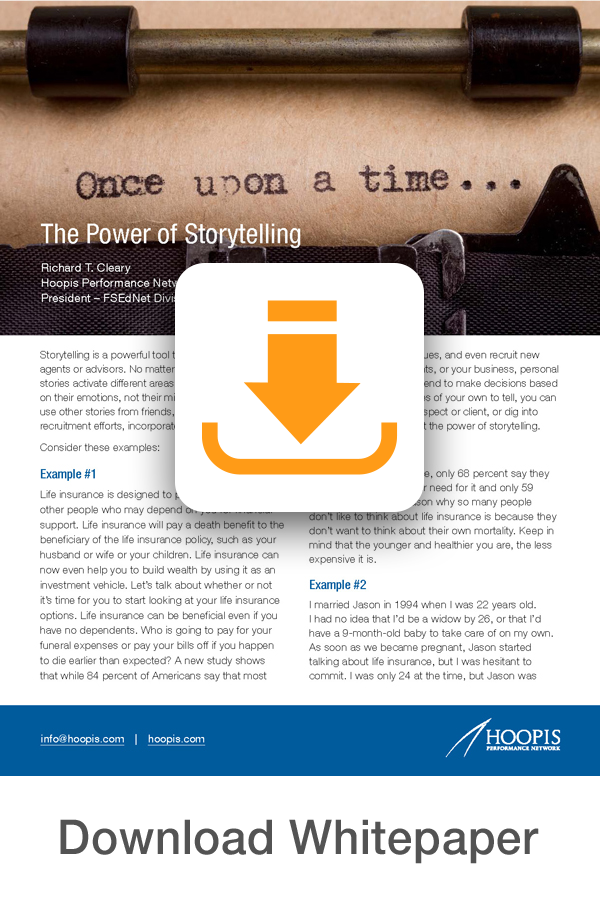The Power of Storytelling

Storytelling is a powerful tool that can help you close more sales, increase your revenues, and even recruit new agents or advisors. No matter what you are selling, whether it is insurance, investments, or your business, personal stories activate different areas of the brain that facts and figures don’t touch. People tend to make decisions based on their emotions, not their minds. If you are worried that you may not have any stories of your own to tell, you can use other stories from friends, family, and colleagues.
Next time you speak with a prospect or client, or dig into recruitment efforts, incorporate a story into your discussion. Let’s take a closer look at the power of storytelling.
Consider these examples:
Example #1
Life insurance is designed to protect your family and other people who may depend on you for financial support. Life insurance will pay a death benefit to the beneficiary of the life insurance policy, such as your husband or wife or your children. Life insurance can now even help you to build wealth by using it as an investment vehicle. Let’s talk about whether or not it’s time for you to start looking at your life insurance options. Life insurance can be beneficial even if you have no dependents. Who is going to pay for your funeral expenses or pay your bills off if you happen to die earlier than expected? A new study shows that while 84 percent of Americans say that most people need life insurance, only 68 percent say they personally recognize their need for it and only 59 percent own it. The reason why so many people don’t like to think about life insurance is because they don’t want to think about their own mortality. Keep in mind that the younger and healthier you are, the less expensive it is.
Example #2
I married Jason in 1994 when I was 22 years old. I had no idea that I’d be a widow by 26, or that I’d have a 9-month-old baby to take care of on my own. As soon as we became pregnant, Jason started talking about life insurance, but I was hesitant to commit. I was only 24 at the time, but Jason was adamant. The topic of life insurance was just plain scary. I was pregnant with our first child, and the last thing I wanted to think about was one of us dying. Jason passed away on a Tuesday in November, right before the holidays. The weekend before, we’d taken our 9-month-old to the beach for the first time. That Monday evening, our neighbors came over for dinner. Jason went to bed early because he had to work early. He was already asleep when I joined him later. The next morning, he left for work without me seeing him. Whether he kissed me goodbye while I slept, I’ll never know. My story is a reminder that once you have a family (no matter your age) life insurance is absolutely essential. I didn’t want to think about it at the time, but lucky for me, my husband had.
The second example tugs on heartstrings that the first one can’t even touch, no matter how compelling the facts are. Here are some reasons why storytelling can more effectively persuade, convince, and sell for you:
The Effectiveness Storytelling Is Scientifically Proven
A data-filled presentation, like example #1, engages only two areas of a listener’s brain:
- The language comprehension (Wernicke’s Area)
- The language processing and comprehension (Broca’s Area)
Stories, on the other hand, can trigger up to seven areas of the brain, making the listener actually experience the story as if it was happening to them. In addition to the ones listed above, stories can also activate the:
- Motor cortex
- Sensory cortex and cerebellum
- Olfactory cortex
- Auditory cortex
- Visual cortex
These are the areas of the brain responsible for movement, touch, colors and shapes, scents, and sounds. Taking time to tell an exceptionally descriptive story can activate all of these areas of the brain, resulting in a truly impactful and motivating presentation.
Stories Invoke Logic and Emotion
Have you heard the phrase, “Facts tell; stories sell?” Here’s why. When you present facts and data to prospects, clients, and potential recruits, you appeal to their sense of logic. While logic is important, study after study proves that consumers make decisions based on their emotions. When you tell a story, you connect with your listener on an emotional level. Buying insurance and making investment decisions are a little different than splurging on a new outfit or jet skis. These are logical decisions and typically large purchases, so logical thinking is important to some degree. Facts can establish credibility and add professionalism to your pitch but activating emotions through storytelling will create a connection that will not only make your listener more engaged but may also build trust and rapport needed for a longterm business relationship. A mixture of facts and storytelling can transform your presentation into a powerful one.
Storytelling Promotes Active Imagination
When you tell a story, your listener imagines the story as if they were there. This can benefit you because without even asking, your listener will put themselves in the shoes of the people in that particular situation. They will subconsciously ask themselves how would they feel and what would they do. The story about the widow can make a husband or wife ask themselves, “What would we do if one of us passed away suddenly? Who would pay the bills or put our kids through college?” These questions will create an emotional and logical appeal to why the cheapest possible insurance policy might not be the right decision for their family.
Storytelling Is Interactive
One common struggle for new insurance agents and investment advisors is the tendency to talk “at a client,” instead of “with a client.” Storytelling gives you the opportunity to interact with your clients or potential recruits in a meaningful way. As you make them part of a discussion through stories and questions that engage them, you are truly interacting with them. When you elicit emotional responses to a story, your conversation becomes more organic and connected. Your clients might only give simple responses of shock, awe, and inspiration, but, a simple response is enough to demonstrate they are hanging on your every word and interacting with you.
People Don’t Like Being Sold
When people feel like they are being “sold to,” they tend to be more skeptical and less trusting. No one likes to be told what to do, especially in an aggressive or demeaning way. Aggressive selling can cause people to shut down and stop listening to your pitch. A strong salesperson will use other techniques that allow the listener to feel like they are in control of their decisions. Stories give you the opportunity to lead prospects, clients, and potential recruits to “obvious conclusions” through strong examples and clear and concise education. As a salesperson connects to the values that are most important to the listener, the listener will feel confident in doing business with you. Storytelling is an effective tool for this.
Powerful Stories Promote Inspired Action
Strong stories with vivid imagery will allow your listeners to imagine themselves in a similar situation and they will be inspired to take action. By taking the time to incorporate storytelling into your sales process, your ability to close the deal will become much easier. When your listeners feel inspired to act, they become more likely to act, whether in buying a policy, making an investment, or accepting an offer of employment.
Our Brains are Wired for Storytelling
A story, if broken down into the simplest form is a connection of cause and effect, which is how our brains work. We think in narratives all day long, whether we are thinking about buying groceries, a situation at work, or the future of our kids. We make up short stories in our heads for virtually every action and conversation, whether we see it or not. Whenever we hear a story, we want to relate it to one of our existing experiences. When we search for connecting experiences, we find connecting emotions such as pain, joy, or disgust to name a few. This is why we tend to understand concepts better when they have a metaphor attached. We automatically connect metaphors to things that happen to us. Everything in our brain looks for the cause and effect relationship in something we’ve previously experienced.
When to Tell a Story
Storytelling can be used in many ways. Effective salespeople will have a story ready for every stage of a sale – clarifying the product, overcoming objections, or answering questions. Some have found it effective in encouraging someone to sign up for auto-draft, longterm care, cancer plans, or even signing paperwork before leaving the office. While you may not feel that you have any stories to tell, ask around and you will find many stories. Here are some examples to get you started.
Creating a Powerful Story
An effective story will be relatable, present a conflict, provide a resolution, and include results. This can also be outlined as having a hero, a challenge, the change process, and a result.
Let’s look at the steps in finding and developing your story into a powerful one.
- Step #1: Start collecting stories. This can be done in the Notes app on your cell phone or somewhere else that is convenient and easily accessible. Whenever you experience, hear, or think of a good story, write it down.
- Step #2: Categorize your stories. What is the “lesson” for each story? Create categories and keep them organized for easy retrieval.
- Step #3: Develop the best stories. Try to remember as many details as possible surrounding your story. If you can’t remember, make them up. You should be able to see, hear, and feel every aspect of the story.
- Step #4: Practice telling your stories. Practice makes perfect. Pay close attention to the most effective speed, pitch, and word choices.
Delivering a Powerful Story
Once you have a stockpile of stories, you need to deliver them effectively. Always:
- Get personal and connect with you audience
- Avoid clichés and complex language
- Be relatable
- Be descriptive
In an examination of the most successful TED presenters, Nayomi Chibana shares these seven tips for delivering powerful stories:
- Immerse your audience in the story. A well told story is something that will stick in your audience’s mind for years to come. Choose your words intentionally, making sure that every word and image you present creates a clear mental picture of your story. Also, it clearly followed a golden rule of presentation-giving which is to use visuals that will supplement your story rather than repeat what has already been said. Another way to immerse the audience in your story is to provide sensory details that will allow them to actually see, hear, feel, and smell the different stimuli in your story world.
- Tell a personal story. Few things are as captivating as a personal story, especially those of triumph over extreme adversity. In his insightful book The Seven Basic Plots, author Christopher Booker finds that there are seven basic story plots that have universal appeal. These include the story of the hero defeating a monster, the rags to – riches tale, rebirth, the quest for a treasure, and the voyage of a hero who comes back a changed person, comedy, and tragedy. These plots are clearly seen in some of the most popular and moving presentations ever given.
- Create suspense. Those who love to watch movies or read books know that a good story always has to have a conflict and a plot. These two elements are what make a good presentation into a roller coaster ride that keeps an audience at the edge of their seats, asking themselves, “What will happen next?” There are several devices that can increase the level of suspense of your story. One way is to tell a story chronologically and build up to a climactic conclusion. Another way is to plop the audience right in the middle of action and then go backwards in time to reveal how all of this occurred.
- Bring characters to life. Characters are at the heart of any story. Their fortunes and misfortunes are what make people want to laugh, cry or rejoice. The most successful stories, I found, were those that created three-dimensional characters who were easy to identify and, at the same time, had an uncommon characteristic. In order to do this, you must provide enough detail to bring the character to life in the minds of those in the audience.
- Show. Don’t tell. Instead of telling your audience about a certain event in a story, try showing them by transporting them to a scene. Whenever you deliver a story, try scene-by-scene construction of events and use dialogue instead of narration.
- Build up to S.T.A.R. moment. Similar to a climax, a S.T.A.R. moment is a “Something They’ll Always Remember” event that is so dramatic that your audience will be talking about it weeks later. According to presentation expert Nancy Duarte in her book Resonate, this can come in the form of a dramatization, provocative images, or shocking statistics.
- End with a positive takeaway. After analyzing 200 of the best TED talks, presentation expert Akash Karia found that the most effective presentations not only had a conflict and a climax, but also a positive resolution. On the path to triumph, most characters in these stories received what he calls a “spark,” or a key piece of wisdom or advice that helped them overcome their obstacles and change for the better . If your story isn’t having the effect you were aiming for, cut it short and move on. Use your instincts to observe your listener and take cues to ensure you stay connected to their needs and interests.
Another technique is getting your client to tell the story. Imagine you’re selling a disability income plan. Ask the client if they have any friends, peers or family members who have experienced a disability and let them tell the story. Telling a story can be even more persuasive than hearing one. An experienced salesman gets their client to do the talking.
Conclusion
Storytelling is a highly effective tool that anyone can use to elicit an emotional response in our listeners. It can illustrate best practices or persuade a hesitant buyer to make an important decision. Most of all, storytelling is a way to connect with your clients and create trust and rapport between you and others.



